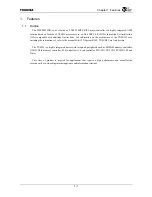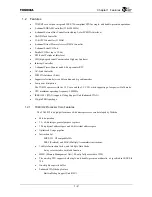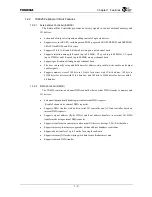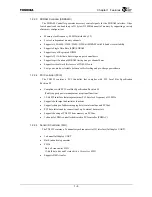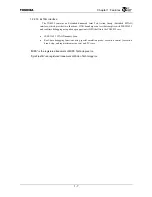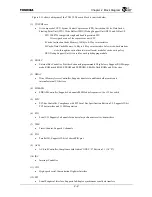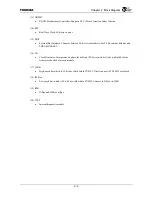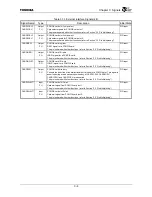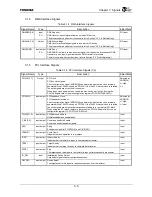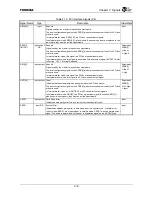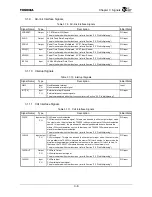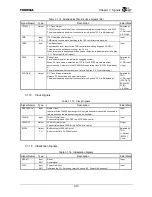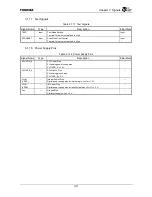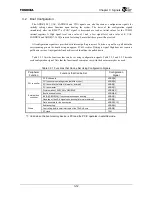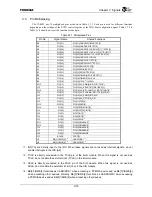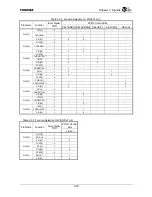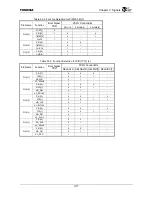
Chapter 3 Signals
3-3
3.1.3
External Interface Signals
Table 3.1.3 External Interface Signals (1/2)
Signal Name
Type
Description
Initial State
SYSCLK Output
System
Clock
Clock for external I/O devices.
Outputs a clock in full speed mode (at the same frequency as the G-Bus clock
(GBUSCLK) frequency), half speed mode (at one half the GBUSCLK frequency), third
speed mode (at one third the GBUSCLK frequency), or quarter speed mode (at one
quarter the GBUSCLK frequency). The boot configuration signals on the ADDR[4:3]
pins select which speed mode will be used.
When this clock signal is not used, the pin can be set to L using the SYSCLK Enable
bit of the pin configuration register (PCFG.SYSCLKEN).
High
UAE Output
PU
Upper Address Enable
Latch enable signal for the high-order address bits of ADDR. This is a Low active
signal.
This signal is also used as a boot configuration input signal for testing. Because this
signal is used for testing, ensure that it will not pulled Low during a reset sequence.
For details of configuration signals, refer to Section “3.2 Boot Configuration”.
This signal is used as an input signal while the RESET
*
signal is asserted. It becomes
an output signal once the RESET
*
signal has been deasserted.
Input
CE[5:4]
*
Output
PU
Chip Enable
Chip select signals for ROM, SRAM, and I/O devices.
The pins are shared with other functions (refer to Section “3.3 Pin Multiplexing”).
All High
CE[3:0]
*
Output
Chip
Enable
Chip select signals for ROM, SRAM, and I/O devices.
All High
OE
*
Output
Output
Enable
Output enable signal for ROM, SRAM, and I/O devices.
High
SWE
*
Output
Write
Enable
Write enable signal for SRAM and I/O devices.
High
BWE[3:0]
*
/BE[3:0]
*
Output
Byte Enable/Byte Write Enable
BE[3:0]
*
indicate a valid data position on the data bus DATA[31:0] during read and
write bus operation. In 16-bit bus mode, only BE[1:0]
*
are used. In 8-bit bus mode,
only BE[0]
*
is used.
BWE[3:0]
*
indicate a valid data position on the data bus DATA[31:0] during write bus
operation. In 16-bit bus mode, only BWE[1:0]
*
are used. In 8-bit bus mode, only
BWE[0]
*
is used.
The following shows the correspondence between BE[3:0]
*
/BWE[3:0]
*
and the data
bus signals.
BE[3]
*
/BWE[3]
*
: DATA[31:24]
BE[2]
*
/BWE[2]
*
: DATA[23:16]
BE[1]
*
/BWE[1]
*
: DATA[15:8]
BE[0]
*
/BWE[0]
*
: DATA[7:0]
The boot configuration signal on the ADDR[11] pin and the EBCCRn.BC bit of the
external bus controller determine whether the signals are used as BE[3:0]
*
or
BWE[3:0]
*
.
All High
ACK
*
/ READY Input/output
PU
Data Acknowledge/Ready
Flow control signal (refer to Section “7.3.6 Access Modes”).
Input
Summary of Contents for TMPR4925
Page 1: ...64 Bit TX System RISC TX49 Family TMPR4925 Rev 3 0 ...
Page 4: ......
Page 15: ...Handling Precautions ...
Page 16: ......
Page 18: ...1 Using Toshiba Semiconductors Safely 1 2 ...
Page 40: ...3 General Safety Precautions and Usage Considerations 3 18 ...
Page 42: ...4 Precautions and Usage Considerations 4 2 ...
Page 43: ...TMPR4925 ...
Page 44: ......
Page 54: ...Chapter 1 Features 1 8 ...
Page 58: ...Chapter 2 Block Diagram 2 4 ...
Page 88: ...Chapter 4 Address Mapping 4 12 ...
Page 226: ...Chapter 8 DMA Controller 8 58 ...
Page 260: ...Chapter 9 SDRAM Controller 9 34 ...
Page 480: ...Chapter 15 Interrupt Controller 15 32 ...
Page 554: ...Chapter 19 Real Time Clock RTC 19 8 ...
Page 555: ...Chapter 20 Removed 20 1 20 Removed ...
Page 556: ...Chapter 20 Removed 20 2 ...
Page 564: ...Chapter 21 Extended EJTAG Interface 21 8 ...
Page 580: ...Chapter 22 Electrical Characteristics 22 16 ...
Page 588: ...Chapter 24 Usage Notes 24 2 ...

